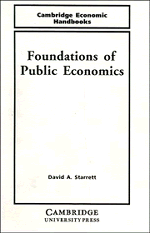Book contents
- Frontmatter
- Contents
- Preface and acknowledgments
- Notation
- PART I Scope and limitations
- PART II Decision making in a mixed economy
- PART III First-order project analysis
- PART IV Evaluating large projects
- 14 Search for exact measures
- 15 Surplus approximations
- 16 Practical methods for large-project evaluation
- 17 Peak-load problem
- Epilog
- References
- Author index
- Subject index
14 - Search for exact measures
Published online by Cambridge University Press: 04 April 2011
- Frontmatter
- Contents
- Preface and acknowledgments
- Notation
- PART I Scope and limitations
- PART II Decision making in a mixed economy
- PART III First-order project analysis
- PART IV Evaluating large projects
- 14 Search for exact measures
- 15 Surplus approximations
- 16 Practical methods for large-project evaluation
- 17 Peak-load problem
- Epilog
- References
- Author index
- Subject index
Summary
Up to now, our project analysis has been conducted in a first-order framework without much discussion of limitations of the approach. Part IV of this book addresses these limitations and develops more general procedures for project analysis when first order is inadequate. Unfortunately, as we shall see, the new methods are much more difficult to implement from a practical point of view. For this reason it is desirable to make the most use we can of the first-order approach.
Assuming that there are no significant indivisibilities, it is always possible to construct general decision-making procedures on the basis of the first-order approach. Each large project (or combination of large projects) can be constructed from a sequence of small projects, and these can be evaluated iteratively using the methods of Part III. To make this procedure operational, we need a rule for deciding the sequence by which projects are introduced. Many rules are possible, but for now let us suppose that they are introduced in order of their “efficiency”; that is, we implement the project with the highest dW/dα first, recompute a status quo, look for the next best project, and iterate. Of course, we stop when there are no more projects that generate a positive increment in welfare.
Iterative planning methods of this type have a long history in the literature. They are known to generate overall optimal performance as long as the economic environment is convex. But they work badly when there are significant elements of increasing returns to scale or other nonconvexities.
- Type
- Chapter
- Information
- Foundations in Public Economics , pp. 233 - 245Publisher: Cambridge University PressPrint publication year: 1988



